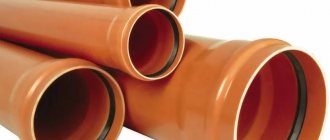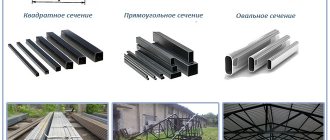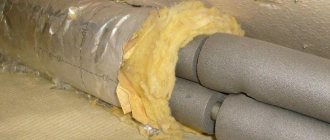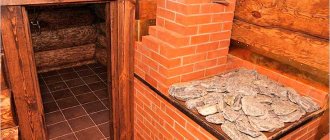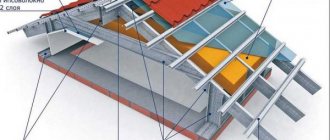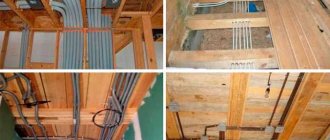As a rule, all engineering communications are laid outside the country cottage in the ground. Therefore, in severe frosts they can simply freeze. To prevent this phenomenon, the pipes must be insulated. Otherwise, a private house will not provide an acceptable level of comfort and convenience for its inhabitants. You can solve this seemingly difficult problem yourself.
Do-it-yourself insulation of sewer pipes
Bury pipes deep into the ground
The most reliable way of insulation is to deepen them into the ground.
The deeper the pipe is, the less likely it is to freeze. After all, at a certain depth the temperature does not change even in winter. How to determine the optimal depth for laying pipes? It is impossible to give universal advice for every locality. In each climate zone, the soil freezes to a different thickness. In some areas it is enough to bury it a meter deep. In others, the ground can freeze up to two meters. Having consulted the climate atlas of your area and determined the depth of freezing, you will be able to carry out excavation work correctly. True, builders advise adding extra space and going a little deeper.
Burying pipes deep into the ground is a good option. However, in practice, this effective and low-cost method of insulation is not always used. Why? Excavation works cause complications even in cases where pipes must be buried a meter deep. If you need to dig deeper, you want to come up with another way to insulate a sewer pipe. In addition, the sites are often located in areas where excavation work is either impossible or very expensive.
By digging deep, you will create another problem. Let's say there is a problem with the system. You're not even sure if there's a leak, but you need to check the pipe. And to do this, you will have to turn over mountains of soil again, inspect, look for damage and bury them back. What if you need to replace one or more sections?
Thermal insulation of drains
In most cases, external sewerage is laid in trenches. This is due to the fact that the principles of operation of the system are based on the gravity flow of wastewater. For this reason, for their normal passage it is necessary to create a height difference in the pipeline. But don’t forget about insulation, which helps protect system elements from freezing or mechanical damage.
SNiP requirements
According to the requirements of SNiP for thermal insulation of sewerage systems, to determine the minimum depth for laying pipes, the experience of operating networks in the area should be studied. If the required information on the minimum depth is not available, then a pipe with a diameter of up to 50 cm is laid to a depth of no more than 0.3 meters. Any part with a circumference greater than 50 cm must be laid in the ground at a distance of at least 0.7 m. To determine the minimum installation depth for collectors with fluctuating wastewater flow rates, static and thermal calculations should be carried out.
Note
In this case, all parts placed at a depth of at least 70 cm must be protected from freezing or mechanical damage.
The above SNiP requirements assume that the external sewerage system was not insulated.
In cases where the pipeline is protected from mechanical stress, or the depth of installation of the system allows it, the sewer system can be located at a shorter distance. This will significantly reduce the amount of work performed, and will also provide access to the drainage system for repairs if the need arises.
Good or bad
The high price of a heat-insulating material does not always indicate its excellent properties. There are unscrupulous manufacturers, and among sellers there are those who like to “inflate” the price. Before choosing and buying insulation, you need to thoroughly study its characteristics and think carefully about everything. It is very good if you can get a sample and conduct some experiments:
- Bring a small piece of thermal insulation material to a bright lamp. Translucent - bad. If sewer pipe insulation allows light to pass through, heat will also pass through it. Such a check is not necessary for materials with additional coating (foil and the like).
- If we are talking about foam material, you need to look at the cut. The air cells should be small, ideally approximately the same. Large air chambers will not retain heat well.
- Set the sample on fire. High-quality insulation does not burn. Some materials for heat insulators are initially flammable, which can be eliminated with the help of special additives.
- Try to pull and tear a fragment of the heat insulator. If this happened very easily, the strength is in doubt. Such material can simply be accidentally damaged during the installation process.
This due diligence will help you make your final choice.
Buyer Information
- ✔ Information on size, weight, prices, photos and other characteristics in the product catalog will help you choose and buy insulation for underground sewer pipes in the online store.
- ✔ Delivery in Moscow and the region is carried out by vehicles with a carrying capacity from 500 kg to 10 tons. Detailed information about the service, conditions and cost can be found on this page.
- ✔ We sell thermal insulation of sewerage pipes in the ground wholesale and retail. At the same time, retail customers can apply for a Petrovich Friends Club card, receive discounts and accumulate points.
Insulation for sewer pipes
Since we are talking about insulating the external sewer system in a private house, let’s consider how to insulate pipes with your own hands
The most important thing in the process of insulating external sewerage is the choice of material that will determine the installation features and provide a given level of reduction in heat loss
It should be noted that sewer insulation, as a separate type, is a non-existent material. Those. There is no single solution, and in each case it is necessary to select insulation based on the individual characteristics of the pipeline.
Thermal insulation of sewer pipes is carried out by any of the thermal insulation materials on the market.
There are only two determining factors when choosing insulation:
climate zone. The lower the winter temperature, the lower the thermal conductivity index the insulation should have;
pipe laying method. The choice of pipe insulation depends on the depth to which the pipes are laid (below or above the freezing level). The technology for insulating external sewers using thermal insulation comes down to two methods: the pipe is wrapped with insulation in several layers or a box is built around it.
Which insulation for sewer pipes is better to choose?
A good building thermal insulator must meet a number of requirements:
- low thermal conductivity coefficient;
- ease of installation;
- resistance to various factors: moisture, biological activity, ultraviolet radiation, mechanical or chemical influences;
- tightness of insulation;
- resource of use;
- price.
Comparative characteristics of thermal insulation materials
In addition to the above, modern industry produces other types of insulation for sewer pipes of a private house. You will learn their thermal insulating properties by studying the table below.
Table of characteristics of various thermal insulation materials
In the table, the letters indicate the class of hygroscopicity and thermal conductivity from the highest level (“A”) to very low (“D”).
Methods for insulating sewer systems
Let's look at several ways to insulate sewer systems that will save you money and won't take much effort during installation.
There are also several other easy ways to insulate sewer pipes.
Method one
The easiest way, it seemed, was to bury the pipes below the freezing level of the soil. But, taking into account that depending on the continental location, each city and suburb has its own level of soil freezing.
Burying pipes below freezing ground is one of the simplest ways. Click to enlarge.
And you will be lucky if it is no more than a meter on your site.
Then there are many more factors why this method of protecting sewer pipes may not be available.
The main factors include the structural features of the soil, proximity to groundwater, the presence of harmful substances and insects that destroy the structure of the pipes. Therefore, such insulation of sewer pipes may not be possible.
It is also worth taking into account repairs in case of a pipe break. It is not necessary that the water supply can freeze; there are a lot of influences, the results of which lead to malfunctions on any section of the laid pipe
It is not necessary that the water supply can freeze; there are a lot of influences, the results of which lead to malfunctions on any section of the laid pipe.
And in order to repair the damaged area, you will have to dig up the pipe again, and it will be good if it is noticeable where the breakdown occurred, and if not, then dig it out completely, and in this case you will have to change it.
So, although this method will cost you little, it is not practical.
Second way
The second method involves insulating sewer pipes by laying an electrical cable. This method is quite reliable, and applies not only to external insulation, but also in houses with a poor heating system.
And the main thing is complete dependence on power supply.
That is, if your electricity is turned off for some reason, you will not receive heating of the pipes.
The second drawback is the hefty bills for electricity consumption. And if something burns out there, or a pipe bursts, it can lead to a short circuit, or, even worse, a fire.
Third way
How to insulate a sewer system in a way that is not resource-intensive and safe, a method is proposed that involves the use of appropriate insulation materials.
Before purchasing such materials, you should pay attention to important properties:
- Durability
- Moisture protection
- Ease of installation
- Flammability
- Material cost
It is also worth considering the characteristics of the insulating material and the possibility of reuse.
Tips for choosing
The method of insulation should be chosen depending on climatic conditions, the depth of the sewerage system and the depth of soil freezing on the land plot. If the pipe is laid at the limit of the permissible depth, it is enough to wrap the pipe with thick penofol or use shells 15-20 mm thick. If it is half a meter higher, you need to use shells 30-40 mm thick. When laying on the surface - shells with a wall thickness of 50 and even 100 mm, the exact indicator depends on the winter temperature in your region. When laying sewer system pipes on the surface or shallow in areas with very cold winters, it is worth consulting an experienced plumbing engineer.
It should be kept in mind that properly installed sewer pipes in the ground rarely freeze. The wastewater flows quickly and does not have time to freeze; the temperature of the waste water is usually not lower than 20 ° C - it does not have time to cool to the freezing temperature.
approximate price
Price of PPS shells:
- Diameter 108 mm, thickness 20 mm – from 297 rub.
- Diameter 108 mm, thickness 30 mm – from 330 rub.
- Diameter 108 mm, thickness 40 mm – from 400 rub.
Price for PPS shells without casing:
- Diameter 108 mm, thickness 40 mm – from 200 rub.
Ways to fight
You can avoid emergency situations and prevent sewer pipes from freezing in the ground by using the following tips:
The laying of the sewerage pipeline must be carried out to a certain depth. It is recommended to place it below the freezing level. The fact is that temperatures at this level do not fall below 1-2°C. This indicator is optimal and allows work to be carried out without the use of insulating materials. If the work is carried out by non-professionals, then this rule is not observed. Pipes are laid above the freezing level, which can create an unusual situation during severe frosts and lead to a breakthrough. This method of deepening is needed when sewer insulation is carried out in a private house, and the owners do not live here permanently. Special materials designed for thermal insulation should be used. The pipes are carefully covered with material that has high thermal insulation properties. It slows down the cooling process and heat loss. Pipe heating is also used using an electric cable specially designed for this purpose. If it is necessary to insulate a device that is subject to freezing, then the pipes are sloped. It is at least 2 cm for every meter. In this case, an electric cable is laid outside the pipe, performing the functions of a heater. In its absence, the pipes freeze, and the frozen water in them forms ice jams.
As a result, the sewer system fails. It is important to properly insulate ventilation pipes. They are located outside, and are brought to the roof surface from the sewer riser
Some of them come from underground and serve to ventilate a septic tank or sewer tanks. When wastewater evaporates, it settles on the inner sides of the pipes. Over time, they freeze and fill the entire system. Residents begin to smell the stench due to a broken ventilation system. The situation can be corrected by pouring a bucket of water into the frozen riser. Only after this should it be insulated. If an electric cable is used for insulation, it must be packaged in corrugation. A plastic container will also work. This will ensure the longevity of the ventilation system.
When to insulate?
With the correct slope and the absence of stagnation areas, the sewer pipe fills only during drainage, and at other times remains dry. The sufficiently high temperature of the wastewater, as well as the release of heat as a result of fermentation, prevents the sewer system from freezing.
However, if the pipeline slope changes due to subsidence or severe frost, the threat of freezing exists. Insulation is advisable if there is the slightest danger of soil freezing in winter to the level of laying sewer pipes or when part of the pipeline passes through cold rooms or the street. In warm climates, insulation measures can be kept to a minimum.
Installation of insulation for sewer lines in the ground
The insulation is installed when all the pipes have already been laid and connected to the sewerage system itself.
In this case, all pipes run at a slope of 1 centimeter per linear meter.
When installing insulation, you should pay special attention to ensure that there are no bare areas left, otherwise this whole procedure will be useless. The beginning and end of the pipe and joints are also carefully processed
In such places, you can put several layers of insulation to be sure.
The beginning and end of the pipe and joints are also carefully processed. In such places, you can put several layers of insulation to be sure.
Otherwise, installation of insulation is very simple and takes little time.
Installation features
Having chosen the desired insulation, immediately read the instructions for it, since each of them has its own characteristics.
If you are additionally doing waterproofing, you should immediately calculate how much material you will need.
More careful insulation and waterproofing should be done on pipe bends; any of the above materials will be suitable for this. Thanks to their convenient cylindrical shape and plasticity, they can repeat any bend without breaking.
You can additionally insulate sewer pipes using a pipe heating cable. It maintains the temperature of the pipe well, preventing it from freezing.
The cable can be an independent insulation, but most often it is wrapped on top with another layer of any insulation.
You can see an approximate diagram of insulation with a heating cable in the figure below.
Insulation with heating cable
This cable provides an almost 100% guarantee that the pipe will not freeze in any conditions.
Installation rules
Insulation with the selected material is carried out before filling the pipe with earth, and all pipe edges and seals must be sealed with sealant so that moisture from the pipes does not spoil the material.
If you choose foam shells for insulation, then you just need to put them on the pipe and additionally secure it with aluminum self-adhesive tape.
If it is mineral wool or basalt fiber, then they must be laid with the foil side out, as shown in the photo below.
Installation of glass wool with waterproofing
In this case, all joints must be glued with construction tape very carefully so that there is no access to moisture.
Also, pipes are insulated only in dry weather; dirt and other debris must be removed from them so that nothing prevents the insulation from tightly joining the pipe.
Electrical cable
This is not exactly the kind of cable that we are used to seeing for outdoor work. This is a metal wire without insulation and with increased resistance.
When an electric current passes through it, it converts it into heat energy. So, when laying such a cable underground, along with drainage pipes, it helps to warm them up in winter.
Active heating using heating elements has its own characteristics and positive aspects:
Heating cable device diagram
- protection of open sewage system;
- heating of communications in boxes, tunnels, channels;
- thermal insulation of collectors installed in the ground.
There are two types of heating elements used when laying communications to heat them:
- resistive - regardless of the time of year or external conditions, it constantly warms up. When using this element, the heating system must be constantly monitored;
- self-regulating – does not require constant monitoring, as it is able to independently assess external conditions and adapt to them.
Scheme of sewer insulation with heating cable
Heating cable design option
This method has a significant disadvantage - dependence on the availability of electricity and good voltage in the network; in the event of an accident - which often happens - there is the possibility of defrosting all communication systems during cold weather. Insulation of drainage systems using electrical cables requires the following preparatory measures:
- Select areas for thermal insulation.
- Calculate the amount of material - in this case cable.
- Decide which heating method will be preferable for you, self-regulating or resistive.
Calculation table for pipe insulation
How to protect sewer pipes from freezing
- engineering;
- using insulation;
- active.
Engineering method
The engineering method is the simplest solution to the question of how to insulate sewer pipes on the street. It consists of the following - pipes are simply laid below the freezing level of the soil. As practice shows, for this they sometimes have to be laid to a depth of 2 m or more. For each region, depending on the climate, the laying depth will be different. This method is implemented as follows:
- A trench is dug to a given depth under the drain pipeline with a slope of 1 cm per meter of its length. The depth can be found in a special table for each region.
- At the bottom of the dug trench, make a sand cushion or a cushion of fine gravel (grain size no more than 20 mm), at least 10 cm thick.
- The pipes are being laid.
- Cover them with a layer of sand or fine gravel. The layer must be located above the pipe at a height of at least 20 cm and be thoroughly compacted.
- Fill the trench with previously removed soil.
Scheme of laying a sewer pipe below the freezing level
Thermal insulation method
What insulation to use is indicated above. The choice of material depends on many factors, among which, first of all, cost and thermal insulation properties should be highlighted.
So, let's look at how to properly insulate a sewer pipe. Installation of an external drainage system using thermal insulation material must be performed in the following sequence:
- The place where the trench will pass is marked.
- A trench is dug, and its width must be at least 60 cm, and its depth must correspond to the design data with a margin of 5–10 cm. The trench is constructed with a mandatory slope (1 cm per 1 linear meter) to ensure gravity flow.
- Sand or gravel at least 10 cm thick is poured into the bottom of the trench and compacted.
- The pipeline is assembled on the surface next to the trench.
- The seal and the edge of the pipe must be lubricated with sealant.
- The insulation is put on the pipe and fixed (usually with tape) so that it does not move.
- The pipe is lowered into the trench, covered with a layer of sand or gravel, and then compacted.
- Next, the trench is finally filled with soil, making sure that it does not contain stones, broken glass or hard soil.
Internal sewerage, as a rule, is not insulated. Only the riser exit to the roof of the house is subject to thermal insulation, since with a sharp temperature change it can simply burst. The material for insulating the riser can also be either mineral wool or foam polystyrene.
Thermal insulating shell for external sewerage pipes
Active method
The most expensive method of thermal insulation is the so-called active insulation. It consists of laying electric heating cables along the pipes. These cables, when heated, transfer heat to the pipeline and prevent it from freezing. The heating system is regulated by a temperature sensor with automatic equipment connected to it. As soon as the temperature around the external sewer system approaches zero, the sensor is triggered and the cable heats the pipeline. When the ground temperature rises, the system automatically turns off.
When using active insulation in practice, you will also need to install an insulation system, because the heating cable will heat the ground, not the pipes. This method is quite expensive both during implementation and operation, and not everyone can afford it.
How to insulate a drain pipe facing the street? The simplest and cheapest method is a foam shell, which will insulate it well. In everyday life, glass wool is more often used, which is simply wrapped around the drain pipe and tied with tape.
Scheme of heating a sewer pipe with a heating cable
Insulated external sewer pipes will last longer if one of the thermal insulation methods described above is implemented. In addition, when laying the system, it is recommended to use smooth pipes made of polyvinyl chloride and polypropylene with an orange surface.
Materials for external drain networks and their prices
Insulation for external sewerage should be chosen correctly, and the price in this case is an important factor. It is important to understand that the insulating coating laid in a well or septic tank will be the key to reliability.
Thermal insulation of pipes: comparison of types
Of the most popular materials for external drainage systems, we can highlight:
- Styrofoam. It consists of small granules. This option does not require additional waterproofing. This building material is produced by sintering granules. This product is very easy to use, is environmentally friendly and lasts a long time.
- Mineral wool. It belongs to the traditional options and is characterized by low cost. However, it is not preferred for sewer mains. Mineral wool cakes over time, plus it has a high hydroscopicity rate. Insulation made from wet mineral wool completely loses all the necessary protective properties.
Foamed polyethylene. This method of insulation for external sewerage is characterized by ease of installation. It is also not afraid of dampness; in such conditions, unlike the previous insulation, it will not lose its properties from getting wet. This type of insulation in rolls has a small thickness, so many layers must be wound onto pipelines for high-quality insulation. You can buy foamed polyethylene in the form of a canvas or in the form of ready-to-use covers of various sizes.- Expanded clay. This method is preferable for external insulation. They simply fill the trench where the highway is located. Only expanded clay is allowed to be used in dry recesses, otherwise its protective properties are lost.
Folgoizol. Produced in two types: SRF and FG. This building material is equipped with fiberglass, which is glued with plastic film. In the production of foil insulation, aluminum or corrugated foil and a bitumen-polymer binder layer are used. A special feature of this type is its very long service life in external communications.
Foamed synthetic rubber. This is a flexible, closed-cell insulation material. It goes on sale in the form of sheets and pipes. Tubular casings can be used for pipelines of any volume. Recently, the popularity of foamed synthetic rubber has decreased.- Expanded polystyrene. Made from suspension polystyrene. During the production process, a foamed material is obtained, consisting of granules securely welded together. The advantage of the material is its high rigidity.
- Penoplex. This is a foamed type that consists of a large number of granules. This option is called the most suitable because penoplex is able to withstand large mechanical loads. This property becomes very important in the current situation. It should be added to the above that penoplex, as an option for drain lines in the ground, can be used in conditions of high humidity.
- Isopon. Most often used as thermal insulation when laying domestic and industrial systems. Its main advantage is its strength and resistance to moisture. Laying isopon is very fast.
- Polyurethane foam. The peculiarity of this type is installation using a special installation, and this costs a lot of money.
- Extruded polystyrene. Has a cellular structure. Ideal for insulating pipelines that are subject to severe loads during operation.
- Basalt. It is made from basalt fibers, which are stitched with glass lines.
- Glass wool. It is characterized by high density. It is often used to insulate metal-plastic sewer pipes. During the thermal insulation process, it is necessary to use additional insulators that protect the insulation from negative environmental factors.
There are also other thermal insulation materials on the market that have certain differences. So, a popular option is considered to be insulation that has a foil layer. This layer reflects thermal energy, which improves the efficiency of insulation.
Foam plastic shells, which are easily mounted on external pipelines of any diameter, are also considered a good option.
Speaking about options for drain lines in the ground, it is necessary to note their affordable cost.
The exact price can be checked with managers when ordering. Also, when ordering, you can receive complete information about the selected product and its characteristics.
Insulation of hood for sewerage background riser
Separately, it should be noted the need to insulate the external sewer system, which means a ventilated background riser (exhaust) - a sewer pipe led to the roof (or to the surface of the ground from a septic tank) and providing ventilation for the pipeline.
The background riser is designed to suck in air so that the pressure in the system is equalized when the toilet is flushed. And in the septic tank, gases are formed from the activity of bacteria, which are also removed through the background pipe.
The ventilation (background) pipe can freeze (condensation freezes and an ice plug forms) and needs to be insulated. Any material that is reliably protected from moisture and destruction by ultraviolet radiation is suitable for thermal insulation. For example, you can put a Stenoflex “stocking” on the pipe. The part of the pipe that is located above the roof is insulated. And you cannot put a cap on top of the pipe; it must be free, otherwise it will freeze in this place.
How to insulate a background riser with your own hands
On the forum, one user suggested an interesting way to get rid of the build-up (freezing) of condensation in a background pipe.
You need to take copper wire (necessarily from pure copper, without braiding, this is important), wind it into a voluminous, but at the same time “liquid” lump (so that air can easily pass through it). Place this lump of wire into the pipe from above, and bend the ends of the wire so that you can secure the wire at the top of the pipe (otherwise it will fall inside)
Place this lump of wire into the pipe from above, and bend the ends of the wire so that you can secure the wire at the top of the pipe (otherwise it will fall inside).
The point lies in the chemical properties of copper; it has very high thermal conductivity. Warm air rises through the pipe, the copper accumulates heat and melts the freezing condensate.
Conclusion
Insulation of sewerage in a private house is an important measure that will maintain the normal flow of sewer pipes in winter, prevent freezing of the pipeline and extend its service life
Insulating material for pipe products 160 mm
Insulation for 160 mm sewer pipes is made from physically foamed polyethylene, its price is approximately 140 rubles.
Freon is not used in its production, so the final product is absolutely safe from an environmental point of view, because it does not affect the environment.
The main material consists of closed cells. Thanks to this device, the insulation for 160 mm sewer pipelines in the ground has excellent thermal insulation and sound insulation characteristics.
Insulation of sewer pipe
The insulation is designed to insulate the heating system, supply of cold and hot water, and sewerage. The thermal conductivity index of this insulating material is 0.0397 W/mK (at an ambient temperature of 10 degrees).
And the density is 20-35 kg/m3. According to fire safety standards, insulation is classified as flammability group G1, and the fire propagation class is RP1. Operating temperature range from -40 to +95 degrees.
The areas of use of insulation 160 are as follows:
- Water and heat supply networks for buildings and buildings.
- Technological lines.
- Ventilation networks.
- Sound insulation and thermal insulation of various networks.
- Protection of pipes from corrosion.
Laying the pipeline below the frost depth
When laying a sewage system on your own, you can try to lay the parts to a depth that will be 10 centimeters below the soil freezing level. With this arrangement, additional thermal insulation of sewer pipes will not be required. Naturally, this is considered an ideal option, but it is used extremely rarely.
Causes:
- The presence of a large amount of work that will have to be carried out when preparing a trench for laying, as well as for digging a hole for a septic tank. If special equipment is not involved, then it is extremely difficult to make such a volume with your own hands.
- In the middle zone, the depth of soil freezing is one and a half meters. It turns out that the pipes will have to be laid to a depth of 1.6 m. In addition, the pipeline must be laid with a slope, so the septic tank must be laid at a depth of two and a half or three meters. The use of such a drainage system is irrational.
- When sewer pipes are too deep, it will be impossible to repair the drain, especially in winter.
It turns out that the choice of the option of deepening below the soil freezing level can be selected only in the case when it is possible to attract special equipment for the work.
Briefly about the main thing
Sewage pipes on the street do not always need to be insulated.
There are only three ways to insulate a sewer pipe: deepening below the freezing level of the soil, using a heating cable, or thermal insulation with rolled or molded materials.
Mineral wool, expanded clay and a group of products made from foamed polymers meet the operating conditions.
It is more convenient to work with insulation materials that are made in the form of a shirt.
The heating cable is relevant for regions with severe frosts.
The trenches are filled with expanded clay.
Read later
